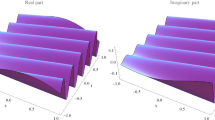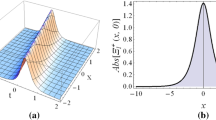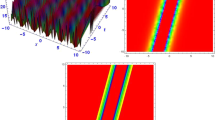Abstract
In optics, the Sasa–Satsuma equation can be used to model ultrashort optical pulses. In this paper higher-order soliton solutions for the Sasa–Satsuma equation with zero boundary condition at infinity are analyzed by \(\bar{\partial }\) method. The explicit determinant form of a soliton solution which corresponds to a single \(p_{l}\)-th order pole is given. Besides the interaction related to one simple pole and the other one double pole is considered.
Similar content being viewed by others
Avoid common mistakes on your manuscript.
1 Introduction
It is well known that the celebrated nonlinear Schrödinger (NLS) equation [23]
can be used to model short soliton pulses in nonlinear optics [1]. To model ultrashort optical pulses, one has to modify the NLS equation and establish new equations. Based on this observation, Kodama and Hasegawa proposed the following higher-order nonlinear Schrödinger (HNLS) equation
where \(q(\xi ,\eta )\) is a complex-valued function, \(\alpha _{1},\alpha _{2},\beta _{j}, j=1,2,3\) are real constants [8]. Generally speaking, the HNLS equation is not integrable unless some restrictions are imposed on \(\beta _{j} (j=1,2,3)\). Sasa and Satsuma [15] consider the following integrable case
Through gauge, Galilean and scale transformations, The Eq. (1) is transformed to a complex modified KdV-type equation
The Eq. (2) is commonly known as Sasa–Satsuma equation, which has been widely studied with various methods such as the inverse scattering scheme [7, 15], Hirota’s bilinear approach [5], Darboux transform [12, 21] and Bäcklund transform [20]. Recently Feng [4] and Yang [22] Studied the Rogue wave of Sasa–Satsuma equation. Much research has been conducted for it, we will not dwell on a detailed exposition of various results.
The aim of this paper is to study higher-order soliton solutions for the Sasa–Satsuma equation by means of \(\bar{\partial }\) method [3, 11, 17, 24]. Soliton solutions corresponding to multiple poles have been investigated in the literature before. Zakharov first given a soliton solution for the NLS equation corresponding to a double pole [23]. Subsequently higher-order soliton solutions have also been studied for the modified KdV equation [19], the sine-Gordon equation [18]. So far various methods have been developed to deal with higher-order solitons, for example the inverse scattering scheme [10, 13, 16, 18, 19, 23], generalized Darboux transform [6], robust inverse scattering transform [14] et al. The motivation of this paper is as follows.
-
1.
Compared with the Riemann–Hilbert method, the \(\bar{\partial }\) method is more directly to derive the soliton solutions. In particular, we will show that \(\bar{\partial }\) method is also a powerful tool to obtain higher-order soliton solutions.
-
2.
Compared to the previous results under the \(\bar{\partial }\) method [10], we will consider more general higher-order soliton solutions and the interaction related to one simple pole and the other one double pole.
This paper is arranged as follows. In Sect. 2, we summary \(\bar{\partial }\)-method for the Sasa–Satsuma equation. In Sect. 3, we derive the explicit determinant form of a higher-order soliton solution which corresponds to one p-th order pole, as well as the interaction related to one simple pole and one double pole is displayed.
2 Summary of \(\bar{\partial }\)-Method for the Sasa–Satsuma Equation
We summarize the already well-known results for the Sasa–Satsuma Eq. (2) that will be used in our study. Here we consider the Sasa–Satsuma equation with zero boundary condition (ZBC) at \(|x|\rightarrow \infty\). To be more precise, q(x, t) decays rapidly for large |x|. The Eq. (2) can be viewed as a compatible condition of the following linear differential equations (also called Lax pair)
where
and
Here the bar denotes complex conjugate and q means q(x, t). In order to establish a connection between Lax pair and \(\bar{\partial }\) problem, we first consider a priori [2] \(\psi (x,t,k)\) for the Eq. (3) which obey the boundary condition
for all \(\textrm{Im}\{k\}\ne 0\). We introduce a modified priori
then \(\Psi (x,t,k)\) satisfies
and
Moreover, we know that \(\Psi (x,t,k)\) and \(\psi (x,t,k)\) are analytic in \(\mathbb {C}/{\mathbb {R}}\), then we can write an asymptotic expansion for \(\Psi (x,t,k)\) when \(k\rightarrow {\infty }\)
Substituting the above expansion into the Eq. (6) and using (5), we have
2.1 \(\bar{\partial }\)-Problem Related to the Sasa–Satsuma Equation
Based on the above analysis, we start from an integral form of the \(3\times 3\) matrix \(\bar{\partial }\) problem \(\bar{\partial }\Psi (k,\bar{k})=\Psi (k,\bar{k}){R(k,\bar{k})}\) with the canonical normalization (7) in the complex k-plane
where \(R(k,\bar{k})\) is a spectral transform matrix and \(C_k\) is the Cauchy-Green integral operator acting on the left and given by
For the sake of simplicity, the arguments \(\bar{k}\) have omitted in the \(\Psi (k,\bar{k})\) and \(R(k,\bar{k})\) from now on. A formal solution of (8) is given by
To establish a connection with Lax pair, we need to introduce the variables x, t into the spectral transform matrix R(k). For the Sasa–Satsuma equation, we assume that R(k) satisfies
From (8), (9) and (10a) we arrive at the first expression of the Eq. (6) and
or
where
and \(\langle {\Psi {R}}\rangle =\langle {\Psi {R}},I\rangle\). The time evolution equation of \(\Psi (x,t,k)\) is implied by (10b) and given by the second expression of the Eq. (6). The above detailed calculations are available in [24]. In fact, the Eq. (6) can be viewed as the another form of Lax pair associated with the Sasa–Satsuma equation.
2.2 Symmetry Conditions and Discrete Spectrum
It is well known that the function \(\Psi (x,t,k)\) in (6) admits the following symmetries [16]
where the superscript \(\dagger\) means the Hermitian conjugation and
From the uniqueness of \(\bar{\partial }\) problem the spectral transform matrix R(x, t, k) satisfies
So we have, elementwise,
Suppose that \(R_{12}(x,t,k)\) has a finite simple pole \(k_{j}~(j=1,2,\ldots ,N)\). Owing to the symmetry conditions (15), the discrete spectrum is the set
In particular, If \(k_{j}\) is a pure imaginary number, i.e. \(k_j=\textrm{i}\lambda _j\), the discrete spectrum set reduces to
2.3 N-Soliton Solutions for the Sasa–Satsuma Equation
In this subsection we consider soliton solutions for the Sasa–Satsuma equation. From the theory of the inverse scattering transform we know that the poles of the reflection coefficient give rise to soliton solutions. Here soliton solutions correspond to the spectral transform matrix R(k) located at the discrete spectrum points of the complex plane where a solution \(\Psi (k)\) of the \(\bar{\partial }\) problem has simple poles. Firstly we consider the discrete spectrum set Z (17), by means of the Eq. (10) and the symmetry conditions (15), we can choose
where \(\delta (k)\) denotes the delta function and \(c_{1j},c_{2j},c_{3j},c_{4j}~(j=1,2,\ldots ,N)\) are given by the following proposition.
Proposition 1
Let \(c_{1j}=\gamma _j\), \(\gamma _j\) is arbitrary complex constant, then the coefficients \(c_{2j},c_{3j},c_{4j}\) are given as follow
Proof
It follows from \({R}_{21}(k)=\overline{{{R}}_{12}(\bar{k})}\) that \(R_0^{21}(k)=\overline{R_{0}^{12}(\bar{k})}\), this is
Let \(-\frac{1}{2\textrm{i}}\iint {f(\ell )}\bullet {d\ell }\wedge {d\bar{\ell }}\) act on \(R_0^{21}(k)=\overline{R_{0}^{12}(\bar{k})}\) and take advantage of the formula
we derive
In the similar way, we can obtain
thus we have (19). \(\square\)
Plugging (18) into (12), we can derive
where G and \(\Psi _{11}\) are N-dimension row vector
and substituting the explicit form of R(k) (18) into the equation in the integral form (8), we derive a linear algebraic system
where I denotes the identity matrix, E is an N-dimensional column vector with an element of 1 and
From (22) and (23), we can obtain the determinant form for N-soliton solution
For example, we take \(N=1\), the 1-soliton solution is
where
and displayed in Fig. 1a.
For the general case (16), similar to the proposition 2.1, we take
where \(\mu ^{\mp }_{j}=\delta (k\pm {k}_j)\), \(\nu ^{\mp }_{j}=\delta (k\pm {\bar{k}_j})\) and \(\alpha _j,\beta _j~(j=1,2,\ldots ,N)\) are arbitrary complex values. As the above process, plugging (25) into (12), we can derive
where G and \(\Psi _{11}\) are 2N-dimensional row vector
Next substituting the explicit form of R(k) (25) into the equation in the integral form (8), we derive the linear algebraic system (23), where I denotes the identity matrix, E is an 2N-dimensional column vector with an element of 1 and \(\Gamma _j, j=1,2\) are the block matrix \(\Gamma _{j}=(\Gamma ^{(mn)}_{j})_{N\times {N}}\),
So we can obtain the determinant form for N-soliton solution
For example, when \(N=1\), Let \(\alpha _1\beta _1\ne {0}\), we obtain spatially localized and temporally periodic bound states [16]. The corresponding single-soliton solutions is displayed in fig.1(b).
3 Higher-Order Soliton Solutions for Sasa–Satsuma Equation
In this section we consider a soliton solution corresponding to a single multiple pole of arbitrary order, that is \(p_{l}\)-th order pole in the point \(k_{l}\). For the sake of simplicity, here we only consider the case \(k_l=i\lambda _{l}\) and take the spectral transform \(R_0\) in the form
where \(\omega ^{(j)}_{l\pm }=\delta ^{(j)}(k\mp \textrm{i}\lambda _l)\). Here the choice of spectral transform \(R_0\) is more general than [10].
As the process described in the Sect.2.3. Plugging (28) into (12) and by means of the formula [9]
we can obtain
where \(\tilde{G}\) and \(\tilde{\Psi }_{11}\) are \((p_l+1)\)-dimensional row vector
Substituting the explicit form of R(k) (25) into the equation in the integral form (8), we derive a linear algebraic system
where
From (29) and (30), by calculation we can obtain the determinant form for \(p_l\)-th order soliton solution in the point \(k_l\)
Example 1
(The second and third order solution) Assuming \(p_{l}=1\), i.e. the spectral transform
and taking account of the formulas (31), the expression for a second order soliton solution in the point \(\lambda _{l}\) can be obtained and is displayed in Fig. 2. Here
When \(p_{l}=2\), from (31) the corresponding third order soliton solution is plotted in Fig. 3.
Remark
If we consider N distinct poles \(k_1,k_2,\ldots ,k_{l},\ldots ,k_N\) and their order are \(p_1, p_2,\ldots ,p_{l}, \ldots ,p_N\) respectively, the spectral transform can be taked in the following form
As the process described in above, we can drive the expression for the general multiple pole solutions similar to the formulas (31). To illustrate, we give an example of the interaction between one simple pole soliton and the other one double pole soliton.
Example 2
(The interaction between one simple pole and the other one double pole) Let us choose \(k_1=\textrm{i}\lambda _1, p_{1}=1, k_2=\textrm{i}\lambda _2, p_{2}=0\), and then the spectral transform (32) in the form
where \(\tilde{\omega }_{\pm }=\gamma _{0}^{1}\omega _{1\mp }+\gamma _{0}^{2}\omega _{2\mp }\). As the process described in above, we can obtain the expression (31) for a soliton solution related to one simple pole and the other one double pole, where
The interaction is shown in Fig. 4.
4 Conclusions and Discussions
We analyzed the process dealing with multiple pole soliton solutions for Sasa–Satsuma equation by means of \(\bar{\partial }\) method in detail. In the frame of \(\bar{\partial }\) problem it’s easy to derive the explicit determinant form of multiple pole solutions. It should be noted that other methods such as the inverse scattering scheme, generalized Darboux transform could be applied as well for multiple pole soliton solution, but the \(\bar{\partial }\) method leads directly to the final results. In this paper the potentials q(x) is considered under ZBC, we know that under nonzero boundary condition it is more complicated to solve double pole solutions by the inverse scattering transform based on Riemann–Hilbert method in the literature [14]. So we will take advantage of this method to the NZBC case in the near future.
Availability of data and materials
Data sharing does not apply to this article as no data sets were generated or analyzed during the current study.
References
Agrawal, G.P.: Nonlinear Fiber Optics. Academic Press, New York (2007)
Beals, R., Coifman, R.: Scattering and inverse scattering for first order systems. Commun. Pure Appl. Math. 37, 39–90 (1984)
Doktorov, E.V., Leble, S.B.: A Dressing Method in Mathematical Physics. Springer, Berlin (2007)
Feng, B.F., Shi, C., Zhang, G., Wu, C.: Higher-order rogue wave solutions of the Sasa–Satsuma equation. J. Phys. A Math. Theor. 55, 235701 (2022)
Gilson, C., Hietarinta, J., Nimmo, J., Ohta, Y.: Sasa–Satsuma higher-order nonlinear Schrödinger equation and its bilinearization and multisoliton solutions. Phys. Rev. E 68, 016614 (2003)
Guo, B., Ling, L., Liu, Q.P.: High-order solutions and generalized Darboux transformations of derivative nonlinear Schrödinger equations. Stud. Appl. Math. 130, 317–344 (2012)
Kaup, D.J., Yang, J.: The inverse scattering transform and squared eigenfunctions for a degenerate \(3\times 3\) operator. Inverse Probl. 25, 105010 (2009)
Kodama, Y., Hasegawa, A.: Nonlinear pulse propagation in a monomode dielectric guide. IEEE J. Quant. Electron. 23, 510–524 (1987)
Konopelchenko, B.G.: Solitons in Multidimensions: Inverse Spectral Transform Method. World Scientific, Singapore (1993)
Kuang, Y., Zhu, J.: The higher-order soliton solutions for the coupled Sasa–Satsuma system via the \(\bar{\partial }\)-dressing method. Appl. Math. Lett. 66, 47–53 (2017)
Luo, J., Fan, E.: A \(\bar{\partial }\)-dressing approach to the Kundu–Eckhaus equation. J. Geom. Phys. 167, 104291 (2021)
Nimmo, J., Yilmaz, H.: Binary Darboux transformation for the Sasa–Satsuma equation. J. Phys. A Math. Theor. 48, 425202 (2015)
Olmedilla, E.: Multiple pole solutions of the nonlinear Schrödinger equation. Phys. D 25, 330–46 (1987)
Pichler, M., Biondini, G.: On the focusing nonlinear Schrödinger equation with nonzero boundary conditions and double poles. IMA J. Appl. Math. 82, 131–151 (2017)
Sasa, N., Satsuma, J.: New-type of soliton solutions for a higher-order nonlinear Schrödinger equation. J. Phys. Soc. Jpn. 60, 409–417 (1991)
Shchesnovich, V.S., Yang, J.: Higher-order solitons in the N-wave system. Stud. Appl. Math. 110, 297–332 (2003)
Sun, S., Li, B.: A \(\bar{\partial }\)-dressing method for the mixed Chen–Lee–Liu derivative nonlinear Schrödinger equation. J. Nonlinear Math. Phys. 30, 201–14 (2023)
Tsuru, H., Wadati, M.: The multiple pole solutions of the sine-Gordon equation. J. Phys. Soc. Jpn. 53, 2908–21 (1984)
Wadati, M., Ohkuma, K.: Multiple-pole solutions of the modified Korteweg–de Vries equation. J. Phys. Soc. Jpn. 51, 2029–2035 (1982)
Wright, O.C.I.I.I.: Sasa–Satsuma equation, unstable plane waves and heteroclinic connections. Chaos Solitons Fract. 33, 374–87 (2007)
Xu, T., Wang, D., Li, M., Liang, H.: Soliton and breather solutions of the Sasa–Satsuma equation via the Darboux transformation. Phys. Scr. 89, 075207 (2014)
Yang, B., Yang, J.: Partial-rogue waves that come from nowhere but leave with a trace in the Sasa-Satsuma equation. Phys. Lett. A 458, 128573 (2023)
Zakharov, V.E., Shabat, A.B.: Exact theory of two-dimensional self-focusing and one-dimensional self-modulation of waves in nonlinear media. Sov. Phys. JETP 34, 62–9 (1972)
Zhu, J., Geng, X.: A hierarchy of coupled evolution equations with self-consistent sources and the dressing method. J. Phys. A: Math. Theor. 46, 035204 (2013)
Acknowledgements
The comments and suggestions of the anonymous referee have been useful.
Funding
This work is supported by the National Natural Science Foundation of China (Grant no. 12001560), Young Teacher Foundation of Zhongyuan University of Technology (no. 2020XQG17), Natural Science Foundation of Henan Province (no. 232300420119).
Author information
Authors and Affiliations
Contributions
YK, BM and XW formally analyze and write original draft. All authors read and approved the final manuscript.
Corresponding author
Ethics declarations
Confict of interest
The authors declare that they have no competing interests.
Ethics approval and consent to participate
Not applicable and All authors consent to participate.
Consent for publication
All authors consent for publication.
Rights and permissions
Open Access This article is licensed under a Creative Commons Attribution 4.0 International License, which permits use, sharing, adaptation, distribution and reproduction in any medium or format, as long as you give appropriate credit to the original author(s) and the source, provide a link to the Creative Commons licence, and indicate if changes were made. The images or other third party material in this article are included in the article's Creative Commons licence, unless indicated otherwise in a credit line to the material. If material is not included in the article's Creative Commons licence and your intended use is not permitted by statutory regulation or exceeds the permitted use, you will need to obtain permission directly from the copyright holder. To view a copy of this licence, visit http://creativecommons.org/licenses/by/4.0/.
About this article
Cite this article
Kuang, Y., Mao, B. & Wang, X. Higher-order soliton solutions for the Sasa–Satsuma equation revisited via \(\bar{\partial }\) method. J Nonlinear Math Phys 30, 1821–1833 (2023). https://doi.org/10.1007/s44198-023-00160-2
Received:
Accepted:
Published:
Issue Date:
DOI: https://doi.org/10.1007/s44198-023-00160-2








